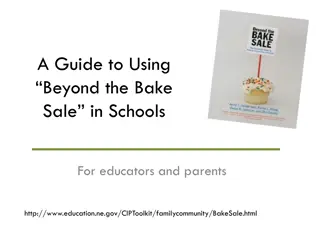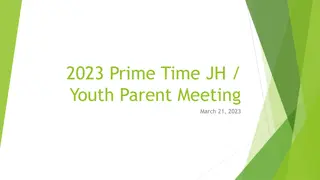Informing Parent Center Work with State Data
This session provides an overview of utilizing state data to inform Parent Training and Information Centers (PTI/CPRC) work. It covers collecting and reporting IDEA data, opportunities for stakeholder collaboration, and prioritized topics for the Parent Center Network. The discussion includes evidence-based education practices, data-driven decision-making, and best practices in family-centered services and technology use. Access to IDEA 618 data, resources from the Center for Parent Information and Resources (CPIR), and the importance of using data to enhance educational outcomes are highlighted.
Download Presentation

Please find below an Image/Link to download the presentation.
The content on the website is provided AS IS for your information and personal use only. It may not be sold, licensed, or shared on other websites without obtaining consent from the author. Download presentation by click this link. If you encounter any issues during the download, it is possible that the publisher has removed the file from their server.
E N D
Presentation Transcript
Using State Data to Inform Parent Center Work
Region 2 Parent Technical Assistance Center (PTAC) Conference Charleston, SC June 25, 2015 June 25, 2015 Presenter: Terry Long, IDC
Purpose of This Session Overview of IDEA data that states collect and report IDEA 618 data SPP/APR SSIP/SIMR Opportunities for stakeholder input and collaboration Discussion about using your state s IDEA data to inform PTI/CPRC work
Priority Topics for the Parent Center Network 1. 2. 3. 4. 5. 6. 7. 8. 9. 10. 11. 12. 13. 14. Evidence-based education practices that improve early learning outcomes Evidence-based education practices that improve school-aged outcomes Evidence-based education practices that improve postsecondary outcomes College- and career-ready standards College- and career-ready assessments School reform efforts to improve student achievement and increase graduation rates The use of data to inform instruction The use of data to advance school reform efforts Best practices in outreach Best practices in family-centered services Best practices in self-advocacy skill building Best practices in nonprofit management Best practices in the use of technology in service provision Best practices in the use of technology in nonprofit management
Center for Parent Information and Resources (CPIR) http://www.parentcenterhub.org/topics/data-driven- decision-making-2/ http://www.parentcenterhub.org/repository/oseps-annual- reports-to-congress/ http://www.parentcenterhub.org/wp- content/uploads/repo_items/rda-guide-for-parent-leaders- advocates.pdf http://www.servingongroups.org/sites/default/files/guideb ook/english/Section6-UnderstandingDataAsInformation.pdf
IDEA 618 Data Reported annually via EDFacts There are 12 data collections authorized under the Individuals with Disabilities Education Act (IDEA) Section 618 Part B eight data collections Part C four data collections Link to U.S. Department of Ed data files http://www2.ed.gov/programs/osepidea/618- data/state-level-data-files/index.html
IDEA 618 Data (cont.) Part B Children With Disabilities Ages 6 Through 21 (1) Child Count (2) Educational Environments (3) Personnel (4) Exiting (5) Discipline (6) Assessment (7) Dispute Resolution (8) Maintenance of Effort Reduction and Coordinated Early Intervening Services Part C Children With Disabilities Ages Birth Through Two (1) Child Count (2) Settings (3) Exiting (4) Dispute Resolution
IDEA 618 Data (cont.) For more detailed information about the contents of each of the IDEA 618 data files that states submit each year to the U.S. Department of Education go to http://www2.ed.gov/about/inits/ed/edfacts/index.html
State Performance Plan (SPP)/Annual Performance Report (APR) Indicator # Indicator Description 1/2 Graduation/Drop Out Rates 3 Statewide Assessment Participation and Performance 4 Discipline Suspension/Expulsion (Significant Disproportionality) 5/6 Education Environments Ages 3-5 and Ages 6-21 7 Early Childhood Outcomes 8 Parent Involvement 9/10 Disproportionate Representation in Identification for Special Education 11 Timely Initial Evaluations 12 Transition from Part C (age 3-5) to Part B (age 6-21) Services 13/14 Secondary Transition IEP Transition Goals and Post-secondary Status 15/16 Dispute Resolution Mediations/Due Process Hearings 17 State Systemic Improvement Plan (SSIP)
SPP/APR Indicators With Predetermined Targets Indicator # Indicator Description Target 1 Graduation Rate ESEA 3 Statewide Assessment Participation and Performance ESEA 4B Discipline Suspension/Expulsion (Significant Disproportionality) 0% 9/10 Disproportionate Representation in Identification for Special Education 0% 11 Timely Initial Evaluations 100% 12 Transition from Part C (age 3-5) to Part B (age 6-21) Services 100% 13 Secondary Transition IEP Transition Goals 100%
SPP/APR Indicators With Stakeholder Input on Targets Indicator # Indicator Description 2 Drop Out Rate 4A Discipline Suspension/Expulsion (Significant Disproportionality) 5/6 Educational Environments Ages 3-5 and Ages 6-21 7 Early Childhood Outcomes 8 Parent Involvement 14 Secondary Transition Post-secondary Status 17 State Systemic Improvement Plan (SSIP), including the State Identified Measurable Result (SIMR)
SSIP Activities by Phase Year 1 - FFY 2013 Delivered by April 2015 Phase I Analysis Year 2 - FFY 2014 Delivered by April 2016 Phase II Plan (Development) Years 3-6 FFY 2015-18 Feb 2017- Feb 2020 Phase III Implementation and Evaluation Reporting on progress, including: Results of Ongoing Evaluation Extent of Progress Revisions to the SSIP Data Analysis Description of Infrastructure to Support Improvement and Build Capacity State-identified Measureable Result Selection of Coherent Improvement Strategies Theory of Action Multi-year plan addressing: Infrastructure Development Support EIS Programs/LEAs in Implementing EBPs Evaluation Plan
State-identified Measureable Result(s) (SIMR) for Children With Disabilities SIMR is a statement of the result(s) the State intends to achieve through the implementation of the SSIP The result(s) may, but need not, be an SPP/APR indicator or a component of an SPP/APR indicator
State-identified Measureable Result(s) (SIMR) for Children With Disabilities (cont.) The result(s) must be clearly based on the Data and State Infrastructure Analyses and must be a student- level outcome in contrast to a process outcome The State may select a single result (e.g., increasing the graduation rate) or a cluster of related results (e.g., increasing the graduation rate and decreasing the dropout rate)
Focus of SIMR by State (Region 2) State Part B SIMR Part C SIMR Delaware Reading/English-Language Arts Early Childhood Outcomes Social Emotional District of Columbia Graduation Early Childhood Outcomes Knowledge & Skills Kentucky Math Family Outcomes Develop and Learn Maryland Math Early Childhood Outcomes Social Emotional North Carolina Graduation Early Childhood Outcomes Social Emotional South Carolina Reading/English-Language Arts Early Childhood Outcomes Social Emotional Tennessee Reading/English-Language Arts Early Childhood Outcomes Knowledge & Skills Virginia Graduation Early Childhood Outcomes Behavior to Meet Needs West Virginia Graduation Early Childhood Outcomes Social Emotional
Region 2 Part B State Data Resources Delaware Special Education/Continuous Improvement Monitoring http://www.doe.k12.de.us/site/default.aspx?PageType=3 &ModuleInstanceID=3251&ViewID=7b97f7ed-8e5e- 4120-848f- a8b4987d588f&RenderLoc=0&FlexDataID=10571&PageI D=183 DC Office of the State Superintendent of Education http://osse.dc.gov/service/specialized-education-data- and-reports4
Region 2 Part B State Data Resources (cont.) Kentucky Department of Education, Division of Learning Services http://education.ky.gov/specialed/excep/Pages/Publ ic-Reporting-of-District-Data.aspx Maryland Department of Education, Office of Special Education and Early Intervention http://marylandpublicschools.org/MSDE/divisions/e arlyinterv/Special_Ed_Info.html
Region 2 Part B State Data Resources (cont.) North Carolina Department of Public Instruction Exceptional Children http://ec.ncpublicschools.gov/reports-data South Carolina Department of Education, Office of Special Education http://ed.sc.gov/agency/programs- services/173/DataCollectionHistory.cfm
Region 2 Part B State Data Resources (cont.) Tennessee Department of Education, Student Support Special Education http://www.tn.gov/education/student_support/data .shtml Virginia Department of Education, Division of Special Education and Student Services http://www.doe.virginia.gov/special_ed/reports_pla ns_stats/index.shtml
Region 2 Part B State Data Resources (cont.) West Virginia Department of Education, Office of Special Programs https://wvde.state.wv.us/osp/datareports.html U.S. Department of Education Part C and Part B Data for All States http://www2.ed.gov/programs/osepidea/618- data/state-level-data-files/index.html
Examples of Ways to Review State IDEA Data Excel spreadsheet with pivot table and graphs
Using State IDEA Data to Inform Your PTI and CPRC Work How do you use state IDEA 618 and Annual Performance Report data to inform ..? Strategic planning Grant writing Annual data reporting Program evaluation
Contact Information Terry Long IDC Consultant terry.long@sped-data.com (615) 512-5871
For More Information Visit the IDC website http://ideadata.org/ Follow us on Twitter https://twitter.com/ideadatacenter
The contents of this presentation were developed under a grant from the U.S. Department of Education, #H373Y130002. However, the contents do not necessarily represent the policy of the Department of Education, and you should not assume endorsement by the Federal Government. Project Officers: Richelle Davis and Meredith Miceli























